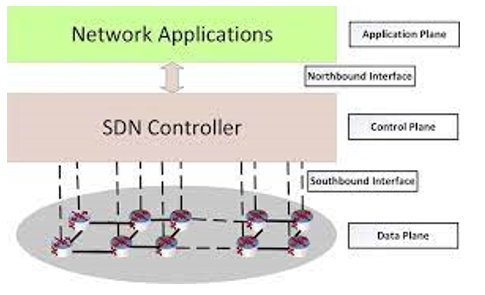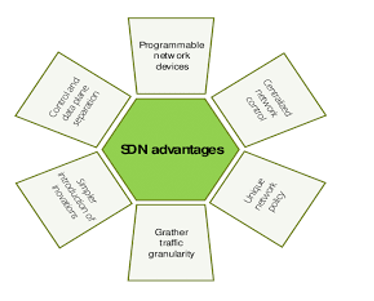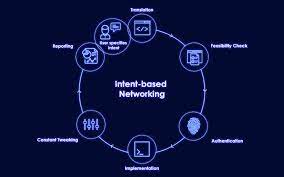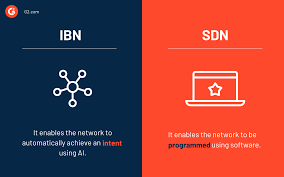Background
SDN, software-defined networking in full, refers to a strategy in networking that utilizes software-based APIs or controllers to interact with established hardware infrastructure and direct network traffic. The approach is different from the traditional networking approach, which uses dedicated hardware gadgets to regulate network traffic (Bera et al., 2017). The software-defined networking can create plus monitor a virtual network via software.
While it becomes possible to break down a virtual network within a physical network with the existence of network virtualization, SDN allows for a new monitoring method of routing data packets via one server. IBN, intent-based networking, refers to a growing technology idea that targets utilizing a more incredible amount of intelligence plus intended state understandings to networking (Beshley et al., 2019). The insights or experiences replace the manual procedures of network configuration and reaction towards network problems. What happens here is that instead of having to code and manually execute tasks, a network administrator can instruct the network on the kind of result they want.

Benefits of SDN and IBN
Many services and applications cannot function without software-defined networking since it enables easy movement of data amongst various locations, which is vital for cloud apps. Moreover, it supports a quick movement of workloads around a network (Bera et al., 2017). For example, breaking virtual networks down into segments enables telecommunication firms to migrate consumer services to cheaper servers or their servers. A service provider can utilize VN infrastructures to migrate loads between cloud infrastructures as needed and create other consumer services accessible immediately. The approach also enables networks to scale as a network administrator adds or removes virtual machines. SDN offering speed and flexibility can support upcoming technologies and trends like edge computing, which requires fast data transfer between remote sites.

On the other hand, IBN has some pros that suggest it is better than the conventional networking scheme and SDN, such as quick troubleshooting and resolution. The fact that IBN continuously monitors itself, performance problems are instantly recognized (Beshley et al., 2019). Another advantage of this approach is the reduced danger of being out of compliance, since it constantly monitors itself and corrects any arising issues, a network can comply with policies established by network administrators. IBN guarantees improved safety since a section of the monitoring process that it does is checking for threats. Therefore, security attacks or breaches are instantly recognized and well observed.
Implementation
In software-defined networking, it is essential to note that decoupling happens between software and hardware. SDN shifts the monitoring panel to decide where traffic is sent to the software, plus exits the part that directs it to the hardware (Bera et al., 2017). This enables a network administrator who uses SDN to program and monitor the whole network through one pane of glass rather than from a gadget to another gadget. There are several components to a software-defined networking scheme positioned in various physical spots, such as applications whose work communicates resource requests or info concerning the entire network.
The second component is controllers, which utilize the information from the first component to choose a method of data packet routing. The last component is networking devices that obtain information from controllers concerning location to migrate the data.
Both physical and virtual networking components migrate the data via a network. Sometimes, a virtual switch, which one could incorporate in hardware or software, takes over the work of a physical switch and merges its functions along with other virtual switches into one intelligent switch, as suggested by (Campanella, 2019). The switch assesses the virtual machine destinations’ integrity and data packets and transfers the packets. Intent-based networking depends on machine learning and artificial intelligence to recommend and do repetitive tasks, respond to system occurrences, develop policies, and verify actions and goals. For instance, IBN can make a server accessible from a particular network if needed to accomplish an intent. The system configures network alterations and verifies if the changes are performed, and it can adapt when needed.

SDN vs. Traditional Networking
The chief difference between the two networking schemes is infrastructure in that the latter is software-based, whereas the former relies on hardware. Due to the control plane being reliant on software, software-defined networking offers much more flexibility than traditional networking (Xie et al., 2018). It enables a network administrator to monitor the network, alter settings, facilitate resources, and raise the network’s capability from a single UI with zero need for any more hardware. Security differences also exist amongst traditional networking as well as software-defined architecture.
Due to better visibility and capability to describe protected paths, software-defined networking provides improved security in various ways. Securing a controller, however, is vital to sustaining a secure network because SDNs use one controller.
Relationship between SDN and IBN
When considering SDN versus IBN, it is great to think of the latter as a form of SDN with extra capabilities. The former refers to managing network infrastructures using software with one pane of glass dashboards (Xie et al., 2018). SDN allows for the automation of multiple time-consuming procedures, which include configuration and scaling of a network. SDN also eases the job for network administrators to configure and reconfigure networks depending on the necessity of supporting a particular application. It offers a network administrator a summary of the whole network and how various network components are working together to achieve the best performance.
The intent-based networking takes SDN a step ahead since it enables the network administrators to carry out network configuration to an address and support a business case instead of just a single task. If a network administrator recognizes their intent, IBN can determine how to achieve that while following set policies (Beshley et al., 2019). This type of network constantly monitors itself for any changes to ensure that it continues to work as projected (Campanella, 2019). If fixing is necessary, the network recommends modifications an operator can choose and apply.

Desktop Virtualization Vs. Back end Infrastructure
Virtualizing a desktop refers to shifting users’ desktops into well-managed and secure data centers that are away from actual desktops. Through decoupling a desktop from a physical location, users can access it via virtually any connection (Li et al., 2020). Also, it guarantees that an organization or a firm’s sensitive information stays safe in its data center instead of roaming free where it could get corrupted (Song et al., 2018). It is important to note that an organization has to invest heavily in good back-end infrastructure to be effective. When a company combines SDN and IBN architectures with virtualization, it benefits from reduced costs, security, improved management of the network components, and efficiency.

References
Bera, S., Misra, S., & Vasilakos, A. V. (2017). Software-defined networking for the internet of things: A survey. IEEE Internet of Things Journal, 4(6), 1994-2008. Web.
Beshley, M., Pryslupskyi, A., Panchenko, O., & Beshley, H. (2019). SDN/cloud solutions for intent-based networking. In 2019 3rd International Conference on Advanced Information and Communications Technologies (AICT) (pp. 22-25). IEEE. Web.
Campanella, A. (2019). Intent-based Network Operations. In 2019 Optical Fiber Communications Conference and Exhibition (OFC) (pp. 1-3). IEEE. Web.
Li, B., Lin, J., Wang, Q., Wang, Z., & Jing, J. (2020). Locally-Centralized Certificate Validation and its Application in Desktop Virtualization Systems. IEEE Transactions on Information Forensics and Security, 16, 1380-1395. Web.
Song, T., Wang, J., Wu, J., Ma, R., Liang, A., Gu, T., & Qi, Z. (2018). FastDesk: A remote desktop virtualization system for multi-tenant. Future Generation Computer Systems, 81, 478-491. Web.
Xie, J., Yu, F. R., Huang, T., Xie, R., Liu, J., Wang, C., & Liu, Y. (2018). A survey of machine learning techniques applied to software-defined networking (SDN): Research issues and challenges. IEEE Communications Surveys & Tutorials, 21(1), 393-430. Web.